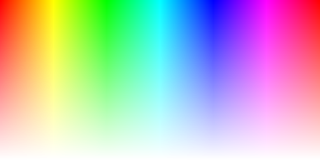
In computer graphics, alpha compositing or alpha blending is the process of combining one image with a background to create the appearance of partial or full transparency. It is often useful to render picture elements (pixels) in separate passes or layers and then combine the resulting 2D images into a single, final image called the composite. Compositing is used extensively in film when combining computer-rendered image elements with live footage. Alpha blending is also used in 2D computer graphics to put rasterized foreground elements over a background.

The Graphics Interchange Format is a bitmap image format that was developed by a team at the online services provider CompuServe led by American computer scientist Steve Wilhite and released on June 15, 1987. It is in widespread usage on the World Wide Web due to its wide support and portability between applications and operating systems.

In computer science and information theory, a Huffman code is a particular type of optimal prefix code that is commonly used for lossless data compression. The process of finding or using such a code is Huffman coding, an algorithm developed by David A. Huffman while he was a Sc.D. student at MIT, and published in the 1952 paper "A Method for the Construction of Minimum-Redundancy Codes".

JPEG is a commonly used method of lossy compression for digital images, particularly for those images produced by digital photography. The degree of compression can be adjusted, allowing a selectable tradeoff between storage size and image quality. JPEG typically achieves 10:1 compression with little perceptible loss in image quality. Since its introduction in 1992, JPEG has been the most widely used image compression standard in the world, and the most widely used digital image format, with several billion JPEG images produced every day as of 2015.
Lossless compression is a class of data compression that allows the original data to be perfectly reconstructed from the compressed data with no loss of information. Lossless compression is possible because most real-world data exhibits statistical redundancy. By contrast, lossy compression permits reconstruction only of an approximation of the original data, though usually with greatly improved compression rates.

Portable Network Graphics is a raster-graphics file format that supports lossless data compression. PNG was developed as an improved, non-patented replacement for Graphics Interchange Format (GIF)—unofficially, the initials PNG stood for the recursive acronym "PNG's not GIF".

Arithmetic coding (AC) is a form of entropy encoding used in lossless data compression. Normally, a string of characters is represented using a fixed number of bits per character, as in the ASCII code. When a string is converted to arithmetic encoding, frequently used characters will be stored with fewer bits and not-so-frequently occurring characters will be stored with more bits, resulting in fewer bits used in total. Arithmetic coding differs from other forms of entropy encoding, such as Huffman coding, in that rather than separating the input into component symbols and replacing each with a code, arithmetic coding encodes the entire message into a single number, an arbitrary-precision fraction q, where 0.0 ≤ q < 1.0. It represents the current information as a range, defined by two numbers. A recent family of entropy coders called asymmetric numeral systems allows for faster implementations thanks to directly operating on a single natural number representing the current information.
Lempel–Ziv–Welch (LZW) is a universal lossless data compression algorithm created by Abraham Lempel, Jacob Ziv, and Terry Welch. It was published by Welch in 1984 as an improved implementation of the LZ78 algorithm published by Lempel and Ziv in 1978. The algorithm is simple to implement and has the potential for very high throughput in hardware implementations. It is the algorithm of the Unix file compression utility compress and is used in the GIF image format.
The BMP file format or bitmap, is a raster graphics image file format used to store bitmap digital images, independently of the display device, especially on Microsoft Windows and OS/2 operating systems.
In information theory, turbo codes are a class of high-performance forward error correction (FEC) codes developed around 1990–91, but first published in 1993. They were the first practical codes to closely approach the maximum channel capacity or Shannon limit, a theoretical maximum for the code rate at which reliable communication is still possible given a specific noise level. Turbo codes are used in 3G/4G mobile communications and in satellite communications as well as other applications where designers seek to achieve reliable information transfer over bandwidth- or latency-constrained communication links in the presence of data-corrupting noise. Turbo codes compete with low-density parity-check (LDPC) codes, which provide similar performance.
3Dc, also known as DXN, BC5, or Block Compression 5 is a lossy data compression algorithm for normal maps invented and first implemented by ATI. It builds upon the earlier DXT5 algorithm and is an open standard. 3Dc is now implemented by both ATI and Nvidia.
FXT1 is a texture compression scheme for 3D graphics, invented by the hardware vendor 3dfx Interactive and offered as an open source rival standard to S3TC in September 1999, a year after S3TC had been adopted by Microsoft as part of DirectX. Limited vendor hardware support has been a barrier to its acceptance. Notably, despite being open source, FXT1 was not adopted by Nintendo for the GameCube, nor by Sony for the PlayStation 3, in both cases losing out to the established S3TC standard. Another possible reason for its lack of adoption is that the CC_MIXED mode probably infringes the S3TC patent.

A Data Matrix is a two-dimensional code consisting of black and white "cells" or dots arranged in either a square or rectangular pattern, also known as a matrix. The information to be encoded can be text or numeric data. Usual data size is from a few bytes up to 1556 bytes. The length of the encoded data depends on the number of cells in the matrix. Error correction codes are often used to increase reliability: even if one or more cells are damaged so it is unreadable, the message can still be read. A Data Matrix symbol can store up to 2,335 alphanumeric characters.
Lossless JPEG is a 1993 addition to JPEG standard by the Joint Photographic Experts Group to enable lossless compression. However, the term may also be used to refer to all lossless compression schemes developed by the group, including JPEG 2000 and JPEG-LS.
Block Truncation Coding (BTC) is a type of lossy image compression technique for greyscale images. It divides the original images into blocks and then uses a quantizer to reduce the number of grey levels in each block whilst maintaining the same mean and standard deviation. It is an early predecessor of the popular hardware DXTC technique, although BTC compression method was first adapted to color long before DXTC using a very similar approach called Color Cell Compression. BTC has also been adapted to video compression.
Ericsson Texture Compression (ETC) is a lossy texture compression technique developed in collaboration with Ericsson Research in early 2005. It was originally developed under the name iPACKMAN and based on an earlier compression scheme called PACKMAN.

Color Cell Compression is a lossy image compression algorithm developed by Campbell et al., in 1986, which can be considered an early forerunner of modern texture compression algorithms, such as S3 Texture Compression and Adaptive Scalable Texture Compression. It is closely related to Block Truncation Coding, another lossy image compression algorithm, which predates Color Cell Compression, in that it uses the dominant luminance of a block of pixels to partition said pixels into two representative colors. The primary difference between Block Truncation Coding and Color Cell Compression is that the former was designed to compress grayscale images and the latter was designed to compress color images. Also, Block Truncation Coding requires that the standard deviation of the colors of pixels in a block be computed in order to compress an image, whereas Color Cell Compression does not use the standard deviation. Both algorithms, though, can compress an image down to effectively 2 bits per pixel.
Adaptive scalable texture compression (ASTC) is a lossy block-based texture compression algorithm developed by Jørn Nystad et al. of ARM Ltd. and AMD.
Apple Video is a lossy video compression and decompression algorithm (codec) developed by Apple Inc. and first released as part of QuickTime 1.0 in 1991. The codec is also known as QuickTime Video, by its FourCC RPZA and the name Road Pizza. When used in the AVI container, the FourCC AZPR is also used.
The Quite OK Image Format (QOI) is a specification for lossless image compression of 24-bit or 32-bit color raster (bitmapped) images, invented by Dominic Szablewski and first announced on 24 November 2021.































